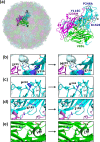Thermal stabilization of enterovirus A 71 and production of antigenically stabilized empty capsids
- PMID: 35997623
- PMCID: PMC10019091
- DOI: 10.1099/jgv.0.001771
Thermal stabilization of enterovirus A 71 and production of antigenically stabilized empty capsids
Abstract
Enterovirus A71 (EVA71) infection can result in paralysis and may be fatal. In common with other picornaviruses, empty capsids are produced alongside infectious virions during the viral lifecycle. These empty capsids are antigenically indistinguishable from infectious virus, but at moderate temperatures they are converted to an expanded conformation. In the closely related poliovirus, native and expanded antigenic forms of particle have different long-term protective efficacies when used as vaccines. The native form provides long-lived protective immunity, while expanded capsids fail to generate immunological protection. Whether this is true for EVA71 remains to be determined. Here, we selected an antigenically stable EVA71 virus population using successive rounds of heating and passage and characterized the antigenic conversion of both virions and empty capsids. The mutations identified within the heated passaged virus were dispersed across the capsid, including at key sites associated with particle expansion. The data presented here indicate that the mutant sequence may be a useful resource to address the importance of antigenic conformation in EVA71 vaccines.
Keywords: EVA71; empty capsids; infantile paralysis; stabilization.
Conflict of interest statement
The authors declare that there are no conflicts of interest.
Figures





Similar articles
-
Production of antigenically stable enterovirus A71 virus-like particles in Pichia pastoris as a vaccine candidate.J Gen Virol. 2023 Jun;104(6):001867. doi: 10.1099/jgv.0.001867. J Gen Virol. 2023. PMID: 37390009 Free PMC article.
-
Production of antigenically stable enterovirus A71 virus-like particles in Pichia pastoris as a vaccine candidate.bioRxiv [Preprint]. 2023 Feb 2:2023.01.30.526315. doi: 10.1101/2023.01.30.526315. bioRxiv. 2023. Update in: J Gen Virol. 2023 Jun;104(6). doi: 10.1099/jgv.0.001867. PMID: 36778240 Free PMC article. Updated. Preprint.
-
Increasing Type 1 Poliovirus Capsid Stability by Thermal Selection.J Virol. 2017 Jan 31;91(4):e01586-16. doi: 10.1128/JVI.01586-16. Print 2017 Feb 15. J Virol. 2017. PMID: 27928008 Free PMC article.
-
EV-A71 Mechanism of Entry: Receptors/Co-Receptors, Related Pathways and Inhibitors.Viruses. 2023 Mar 18;15(3):785. doi: 10.3390/v15030785. Viruses. 2023. PMID: 36992493 Free PMC article. Review.
-
Advances in novel vaccines for foot and mouth disease: focus on recombinant empty capsids.Crit Rev Biotechnol. 2019 May;39(3):306-320. doi: 10.1080/07388551.2018.1554619. Epub 2019 Jan 17. Crit Rev Biotechnol. 2019. PMID: 30654663 Review.
Cited by
-
Production of antigenically stable enterovirus A71 virus-like particles in Pichia pastoris as a vaccine candidate.J Gen Virol. 2023 Jun;104(6):001867. doi: 10.1099/jgv.0.001867. J Gen Virol. 2023. PMID: 37390009 Free PMC article.
-
Production of antigenically stable enterovirus A71 virus-like particles in Pichia pastoris as a vaccine candidate.bioRxiv [Preprint]. 2023 Feb 2:2023.01.30.526315. doi: 10.1101/2023.01.30.526315. bioRxiv. 2023. Update in: J Gen Virol. 2023 Jun;104(6). doi: 10.1099/jgv.0.001867. PMID: 36778240 Free PMC article. Updated. Preprint.
-
Development of enterovirus trans-encapsidation assays as tools to understand viral entry.bioRxiv [Preprint]. 2025 Jul 11:2025.07.11.664324. doi: 10.1101/2025.07.11.664324. bioRxiv. 2025. PMID: 40672215 Free PMC article. Preprint.
-
Molecular Determinants of Human Rhinovirus Infection, Assembly, and Conformational Stability at Capsid Protein Interfaces.J Virol. 2022 Dec 14;96(23):e0084022. doi: 10.1128/jvi.00840-22. Epub 2022 Nov 14. J Virol. 2022. PMID: 36374110 Free PMC article.
-
Enterovirus-like particles encapsidate RNA and exhibit decreased stability due to lack of maturation.PLoS Pathog. 2025 Feb 4;21(2):e1012873. doi: 10.1371/journal.ppat.1012873. eCollection 2025 Feb. PLoS Pathog. 2025. PMID: 39903789 Free PMC article.
References
Publication types
MeSH terms
Substances
Grants and funding
LinkOut - more resources
Full Text Sources

